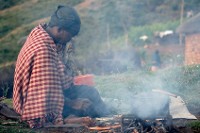Improving Energy Access for the Poor
In 2011 IIASA scientists launched a new Web-based interactive energy access policy analysis tool (ENACT). The tool is intended to help policymakers interactively assess future policy choices and their effectiveness in achieving universal modern energy access goals by 2030. Decision makers can use ENACT to visualize the costs and benefits of specific policy choices and also to improve their understanding of the likely impacts of the choices they make on the development of future demand for household energy and overall access to it.
IIASA researchers, using ENACT, found that the total population dependent on biomass such as dried dung, wood, and charcoal for cooking – in Africa and two Asian regions alone – will rise from 2.2 billion in 2005 to 2.3 billion by 2030 unless there is improved accessibility to clean cooking fuel like liquefied petroleum gas (LPG). Analyses of the future of electrification in developing countries, also indicated that over 800 million rural inhabitants of South Asia and sub-Saharan Africa are likely to remain unelectrified by 2030 without new targets. This has adverse implications for human well-being, in particular health, and for greenhouse gas emissions.
Scientific journal articles
Two journal special issues published in 2011, co-edited by ENE researcher Shonali Pachauri, explored numerous related themes.
Papers in Current Opinion in Environmental Sustainability (COSUST) on “energy security and energy access—interconnected global challenges,” looked at the scale of the energy access challenge, its gender dimensions, the challenges of rural electrification, and the financing required to ensure sustainable energy access.
Papers in Energy Policy on “household cooking fuels and technologies in developing countries,” focused on the use of clean cooking fuels and stove adoption in developing economies.
Young Scientists help develop MESSAGE-Access model
IIASA's MESSAGE-Access model is also used in the area of clean energy access, to help accelerate universal transition to modern energy sources and technologies, by allowing the assessment of future transitions in household energy use and the costs of alternative policies.
In 2011 two Young Scientists Summer Program (YSSP) participants worked on developing and refining MESSAGE-Access. The YSSPers incorporated a wider range of technical options for decentralized electricity supply for expanding access to electricity in South Asia into the model. The model's regional coverage was also expanded, enabling policy scenarios for improved modern cooking fuels and stove access in China to be explored. Both YSSP projects culminated in papers that have been submitted for publication to international scientific journals.
Related Programs
Options: Feature Articles
IIASA Annual Report 2011


